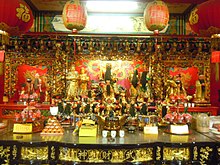| Revision as of 00:14, 8 May 2019 edit2605:e000:1521:63bd:5ed:930b:f4b:3ade (talk)No edit summaryTags: Mobile edit Mobile web edit← Previous edit | Revision as of 00:14, 8 May 2019 edit undoClueBot NG (talk | contribs)Bots, Pending changes reviewers, Rollbackers6,438,834 editsm Reverting possible vandalism by 2605:E000:1521:63BD:5ED:930B:F4B:3ADE to version by 2601:5CC:8200:2510:C196:47CA:5E82:7D85. Report False Positive? Thanks, ClueBot NG. (3624075) (Bot)Tag: RollbackNext edit → | ||
| Line 1: | Line 1: | ||
| {{Chinese|title='''God of Wealth''' / '''Caishen'''| | {{Chinese|title='''God of Wealth''' / '''Caishen'''| | ||
| |pic=武財神.JPG|piccap=Altar of the martial form of Caishen (central statue) at the Temple of the Dragon and the Phoenix (龍鳳宮), in the ] of ]. | |pic=武財神.JPG|piccap=Altar of the martial form of Caishen (central statue) at the Temple of the Dragon and the Phoenix (龍鳳宮), in the ] of ]. | ||
| |t={{linktext|財神}}|s={{linktext|财 |
|t={{linktext|財神}}|s={{linktext|财神}} | ||
| |p=Cái Shén|w=Tsai2 Shen2|poj=Chhâi-sîn|tl= Tsâi-sîn |h=Choy Sin|j=Coi4 San4|y=Chòih Sàhn | |p=Cái Shén|w=Tsai2 Shen2|poj=Chhâi-sîn|tl= Tsâi-sîn |h=Choy Sin|j=Coi4 San4|y=Chòih Sàhn | ||
| |kanji=|hiragana=|romaji= | |kanji=|hiragana=|romaji= | ||
Revision as of 00:14, 8 May 2019
| God of Wealth / Caishen | |||||||||||||||||||||||||
|---|---|---|---|---|---|---|---|---|---|---|---|---|---|---|---|---|---|---|---|---|---|---|---|---|---|
 Altar of the martial form of Caishen (central statue) at the Temple of the Dragon and the Phoenix (龍鳳宮), in the Miaoli County of Taiwan. Altar of the martial form of Caishen (central statue) at the Temple of the Dragon and the Phoenix (龍鳳宮), in the Miaoli County of Taiwan. | |||||||||||||||||||||||||
| Chinese name | |||||||||||||||||||||||||
| Traditional Chinese | 財神 | ||||||||||||||||||||||||
| Simplified Chinese | 财神 | ||||||||||||||||||||||||
| |||||||||||||||||||||||||
| Vietnamese name | |||||||||||||||||||||||||
| Vietnamese | Thần Tài | ||||||||||||||||||||||||
| Chữ Nôm | 神財 | ||||||||||||||||||||||||
Caishen (simplified Chinese: 财神; traditional Chinese: 財神; lit. 'God of Wealth') is the Chinese god of prosperity worshipped in the Chinese folk religion and Taoism. He has been identified with many historical figures, viewed as his embodied forms, among whom Zhao Gongming (趙公明, Wade–Giles: Chao Kung-ming, also known as Zhao Gong Yuanshuai 趙公元帥 "Lord Zhao the Marshal"), Fan Li, and Bi Gan. A large temple of Caishen has been built in the 2000s in Zhouzhi, Xi'an, Shaanxi.
Caishen's name is often invoked during the Chinese New Year celebrations. He is often depicted riding a black tiger and holding a golden rod. He may also be depicted with an iron tool capable of turning stone and iron into gold.
Historical personages

Several versions of Caishen's incarnations' political affiliation and way of deification are circulated. It is unclear whether they are genuine historical figures, though most of the stories agree that Caishen's most popular incarnation lived during the early Qin dynasty. Most probably it represents the merging of several heterogeneous legends, the one of Bi Gan being the most ancient.
Legend has it that Bi Gan had a wife with the surname Chen. His son was Quan (泉). After Bi Gan was put to death by his nephew King Zhou of Shang, Bi Gan's wife and son escaped into the woods. His death eventually marked the collapse of the Shang dynasty. Later on, Quan was honoured as the ancestor of all Lins by King Wu of Zhou.
Notwithstanding the above, there is another legendary character of the Chinese God of Wealth which is generally known as Caibo Xingjun (財帛星君) amongst Chinese communities. Li Guizu (李詭祖) was born in the Zichuan District in Shandong Province and held position as a country magistrate. Li Guizu contributed significantly to the district, whilst people built a temple to worship Li Guizu after his death. The late Li Guizu was then conferred the title Caibo Xingjun by the Wude Emperor of Tang dynasty.
The Caishen of all directions
| No. | Direction | Name | Title |
|---|---|---|---|
| 1 | Center (Chinese: 中路財神) | Zhao Gong Ming (Chinese: 趙公明) | Military God of Wealth (Chinese: 武財神) |
| 2 | East (Chinese: 東路財神) | Xiao Sheng (Chinese: 蕭升) | God of Collecting Treasures (Chinese: 招寶天尊) |
| 3 | West (Chinese: 西路財神) | Cao Bao (Chinese: 曹寶) | God of Collecting Valuables (Chinese: 納珍天尊) |
| 4 | North (Chinese: 北路財神) | Yao Shao Si (Chinese: 姚少司) | God of Profitability (Chinese: 利市仙官) |
| 5 | South (Chinese: 南路財神) | Chen Jiu Gong (Chinese: 陳九公) | God of Attracting Wealth (Chinese: 招財使者) |
| 6 | South-East (Chinese: 東南路財神) | Han Xin Ye (Chinese: 韓信爺) | God of Gambling (Chinese: 大賭神) |
| 7 | South-West (Chinese: 西南路財神) | Liu Hai (Chinese: 劉海) | God of Luck (Chinese: 偏財神) |
| 8 | North-East (Chinese: 東北路財神) | Shen Wanshan (Chinese: 沈萬山) | God of Gold (Chinese: 金財神) |
| 9 | North-West (Chinese: 西北路財神) | Tao Zhugong (Chinese: 陶朱公) | Civil God of Wealth (Chinese: 文財神) |
Caishen sometimes appears as a door god in Chinese and Taoist temples, usually in partnership with the Burning-Lamp Taoist.
Buddhism
Though Caishen is a Chinese folk deity, many Pure Land Buddhists venerate him as a buddha. In esoteric Buddhist schools he is identified as Jambhala.
Notes
External links
 Media related to God of Wealth at Wikimedia Commons
Media related to God of Wealth at Wikimedia Commons